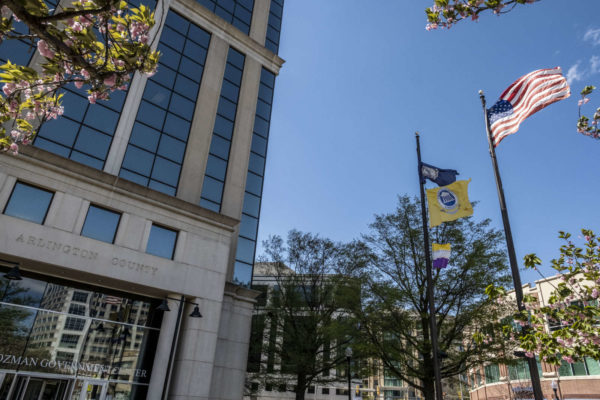
Arlington County has filed a response to the Missing Middle lawsuit against it.
Ten residents are suing the county, arguing that the recently-passed zoning changes known as Missing Middle were approved illegally and would allow development that harms their lives.
In a response shared with ARLnow, dated last Tuesday, May 23, the county argues that the plaintiffs did not prove they, in particular, will be harmed by any new development. It also disputes the claims that the county broke specific provisions in Virginia law related to zoning deliberations and meeting procedures.
Now that both sides have made their cases in writing, a hearing in the civil division of Arlington County Circuit Court is set for July 11 at 10 a.m. In other recent zoning battles in Virginia courts, the lower courts ruled in favor of the county government, while the state Supreme Court overturned those decisions.
The complaint against the county was filed in April, about a month after the Arlington County Board ratified zoning changes that allow the construction of 2-6 unit homes on lots previously zoned for single-family homes.
The plaintiffs complained their property values will be hurt and their quality of life diminished by any new “Expanded Housing Option” or EHO development.
They also said the Arlington County Board failed to properly advertise what was being considered and did not do the due diligence needed to understand the impact of increased density on the neighborhood level.
Arlington County is challenging the legitimacy of the lawsuit, asking the court to rule that the facts of the Missing Middle saga invalidate the claims and dismiss the case so it cannot come before the court again.
On substantive grounds, the county challenges the 10 residents, saying they failed to show the zoning changes will burden them such that the county must provide relief.
For instance, the plaintiffs predicted several negative impacts as a result of the change: increased flooding, sewage backups, school overcrowding and difficulty driving on narrow streets cramped with cars parked on the street. Arlington County says that is speculative at best.
“No property has been developed under the terms of the Zoning Amendment, and any allegations of harm are pure speculation,” the county said in its lawsuit. “The court cannot be asked to issue an advisory opinion based on hypothetical facts.”
The 10 residents also say the Arlington County Board did not consider a long list of societal impacts of which state code requires consideration prior to zoning code changes.
Just because it did not conduct the “special studies or investigations” the plaintiffs claimed were necessary does not mean the factors were not considered at all, Arlington County argues.
“The Board Report, the testimony of the County’s professional staff, and the testimony of the members of the County’s Planning Commission, Housing Commission, Transportation Commission and other advisory commissions and public speakers shows that the County Board adequately considered the factors in [state code],” the suit says.
The plaintiffs also claim the county exceeded its authority when it instituted tree canopy requirements tied to the number of units on a property. They said it violates the Dillon Rule to require more than what is required in the Chesapeake Bay Preservation Ordinance.
Arlington County sees it differently.
“The county amended its zoning ordinance to create an incentive for tree plantings in exchange for increased density, as permitted through its power to administer incentive zoning,” it says.
The county is also challenging the suit on procedural grounds, saying that the plaintiffs need to give the court all of the documents they referenced. This is germane because the substance of at least one document is disputed.
In the County Board meeting when the changes were approved, a document was produced. The plaintiffs allege it included the mechanism Board Chair Christian Dorsey introduced in the meeting for regulating the dispersal of EHO permits, alloted by zoning district.
They say people “had no notice” of how Dorsey proposed to distribute the permits before they were produced in the final meeting.
The county, meanwhile, says this document was merely an outline for discussing specific sections of the ordinance, “not a substantive document furnished to the Board Members for their policy consideration.”
Further, the county argues that this document did not have to be furnished ahead of time online for everyone to read. Open meeting laws only require that documents be made “available for public inspection at the same time such documents are furnished to members of the public body,” per the lawsuit.
(The Executive Director of the Virginia Coalition of Open Government previously confirmed this standard for public information introduced at public meetings to ARLnow.)
As for allegations of other rule violations, the county said the notices it posted ahead of the Missing Middle vote meet requirements of state law. The county’s filing also argues that the notices cannot have been too confusing or improper, as the plaintiffs spoke during the public comment period in question.
“Plaintiffs had actual notice of, and participated in, the Board’s hearing, and thereby waived any alleged defect in the statutory notice required,” the lawsuit says.

